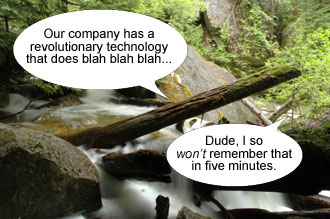and nobody is able to repeat it, does it make a sound?
Okay, maybe a bit corny in the repurposing of that famous existential question, but the key point is this:
Your elevator pitch is only as good as the ability of your listener to repeat it. It’s not about cramming your entire story into a single breath but about providing resonance with the listener. If he/she forms no meaningful association and ascribes no importance to it, it is quickly forgotten. The converse is that it’s grokked in a personal and meaningful way and will be recalled in a later situation when appropriate. And the difference is that the message will then be re-transmitted.
 This point was hammered home in an exercise we did recently in our Fasttrac Growth Venture class. Typically at the beginning of every class each student delivers the most refined version of his/her elevator pitch to the class and gets feedback. The twist in the latest exercise was that you didn’t deliver your own pitch, you had to deliver somebody else’s. Class began as usual but instead of giving our pitch we were told to point at another student. Once every student was pointing at someone unique, each pointee was told to recite the pointer’s pitch.
This point was hammered home in an exercise we did recently in our Fasttrac Growth Venture class. Typically at the beginning of every class each student delivers the most refined version of his/her elevator pitch to the class and gets feedback. The twist in the latest exercise was that you didn’t deliver your own pitch, you had to deliver somebody else’s. Class began as usual but instead of giving our pitch we were told to point at another student. Once every student was pointing at someone unique, each pointee was told to recite the pointer’s pitch.
This exercise wasn’t so much a test of if people were paying attention or not- it was more a test of the transmissibility of the pitches themselves. In other words, an inability to accurately relay someone else’s pitch is more a reflection on the weakness of the pitch vs. the deficiency of the listener. This is a simple yet mind-blowing exercise that demonstrates the importance of how the messaging is received. Unless you’re pitching a potential investor, the role of your pitch is a condensed sound bite for your company that stakes a piece of mental real estate in that person’s mind so that next time he/she meets someone at a cocktail party that needs what you have, you come to mind immediately.
So the takeaway is this:
 Crafting a pitch in the absence of feedback is like spending energy to build the perfect steel-reinforced bridge half-way across a river- it’s pointless unless it connects to the other side. Try out your pitch on some friends. Then approach them three days later and ask them to repeat what they remember. Whatever comes back is what stuck – it is the essence of how your pitch is currently received. Just like the game of telephone where the message gets garbled in re-transmission, your pitch is only as good as that final version which gets relayed second-hand at the cocktail party. Doing recon on that second-generation essence gives you invaluable info about how your pitch needs to be altered.
Crafting a pitch in the absence of feedback is like spending energy to build the perfect steel-reinforced bridge half-way across a river- it’s pointless unless it connects to the other side. Try out your pitch on some friends. Then approach them three days later and ask them to repeat what they remember. Whatever comes back is what stuck – it is the essence of how your pitch is currently received. Just like the game of telephone where the message gets garbled in re-transmission, your pitch is only as good as that final version which gets relayed second-hand at the cocktail party. Doing recon on that second-generation essence gives you invaluable info about how your pitch needs to be altered.







Thanks, Sean. I’m working on a non-profit project in need of an elevator pitch. What you’ve relayed here will be forefront in my mind as it’s crafted… and tested on friends.
[…] The takeaway here is that we spend a great deal of energy trying to spread the word when we would be better served to improve the longevity of the word for the people that it reaches. It’s not what you come away with that ultimately matters- it’s what stays with you over time. Along the lines of a post I wrote awhile back called “If an elevator pitch falls in the woods…†– the weakest link of the re-transmissability of a message is its stickiness, not its buzz-worthiness. The notes I drew up are mostly for my own edification of these concepts and to have a reference but hopefully you find them useful as well. buzzmarketing madetostick marketing tippingpointPass it along:These icons link to social bookmarking sites where readers can share and discover new web pages. […]